Accelerator Science and Engineering Traineeship
Read testimonials from current and former ASET graduate students and view real-world examples of academic theses from the ASET program.
See the extraordinary work MSU students conduct at FRIB
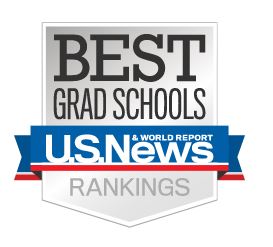
Within FRIB, the Accelerator Science and Engineering Traineeship (ASET) program prepares students to work on groundbreaking research in cryogenics, accelerator, and superconducting radio frequency sciences and technology. These scholars—many of whom subsequently work in national laboratories—gain hands-on, practical training using the world’s most powerful rare isotope accelerator at FRIB.
The opportunities available to students in the ASET program are supported by a history of success:
- MSU’s nuclear physics graduate program has been a top-ranked program nationally for 29 years, according to U.S. News & World Report.
- Over the past five years, MSU has awarded about 15 percent of the nuclear physics doctoral degrees.
- The Carnegie Foundation classified MSU as an institution with very high research activity, one of only 146 nationwide.
Developed with expert MSU faculty, a typical academic thesis in the ASET program is designed to improve areas of accelerator science and technology but may also include advances for areas such as medicine, homeland security, and more.
The ASET academic thesis at MSU
In FRIB’s ASET program, master’s and PhD level candidates work within a research group or on a specific project as part of their academic thesis. Through the curriculum, students are pushed to think differently about complex problems—all while being supported by renowned faculty in one of the most prestigious U.S. nuclear physics graduate programs.
All student research is possible because of the technology available at FRIB.
Academic thesis: Real-world examples from ASET participants
- Mitchell Schneider (PhD)
- Topic: Advancing Field Emission Technology for High Power Injectors Operating GHz and Beyond
- Defense date: 2/4/22
- Current position: Postdoc, SLAC National Accelerator Laboratory
- Crispin Contreras-Martinez (PhD)
- Topic: Electromagnetic and Mechanical Properties of Medium β SRF Elliptical Cavities
- Defense date: 5/26/21
- Current position: Engineering physicist II, Fermi National Accelerator Laboratory
- Bryan Isherwood (PhD)
- Topic: Characterization of Electron Cyclotron Resonance Ion Source Instabilities by Charged Particle Diagnostics
- Defense date: 8/7/20
- Current position: Industry radio-frequency expert, Raytheon Technologies
- Andrew LaJoie (PhD)
- Topic: Viability and Characterization of a Plasma Window as a Flow Limiter for an Ion Beam Gas Charge Stripper
- Defense date: 11/13/20
- Current position: Postdoc, Los Alamos National Laboratory/University of New Mexico
- Cristopher Richard (PhD)
- Topic: Analysis Techniques and Diagnostics of Low β Hadron Beams
- Defense date: 11/16/20
- Current position: Postdoc, Photo Injector Test Facility PITZ (Germany)
- Kellen McGee (PhD)
- Topic: High-Q Development for Novel Medium-Velocity 644 MHz 5-cell Elliptical Cavities
- Defense date: 4/18/23
- Current position: Engineering physicist II, Fermi National Accelerator Laboratory
- Topic: High-Q Development for Novel Medium-Velocity 644 MHz 5-cell Elliptical Cavities
- Michael Balcewicz (PhD)
- Topic: Free Space Charge Dominated Instabilities and Resonances in Synchrotrons
- Defense date: 5/3/23
- Current position: Postdoc, Fermi National Accelerator Laboratory
- Topic: Free Space Charge Dominated Instabilities and Resonances in Synchrotrons
- Elliot Lu (PhD)
- Topic: Numerical Investigation of Collective Effectives in Quantum Optical Media via Integral Operator Electric Fields
- Defense date: 5/8/23
- Current position: Application software engineer, MathWorks
- Topic: Numerical Investigation of Collective Effectives in Quantum Optical Media via Integral Operator Electric Fields
- Nicholas Valverde (PhD)
- Topic: Ion Accelerator Applications, Compact RF Linear Architectures and Machine Learning for Real Time Tuning and Optimization
- Defense date: 2/29/24
- Current position: Machine learning and data scientist, National Security Agency
- Topic: Ion Accelerator Applications, Compact RF Linear Architectures and Machine Learning for Real Time Tuning and Optimization
- Christhian Gonzalez-Ortiz (PhD)
- Topic: Resonance Compensation Studies at the FNAL Recycler Ring
- Defense date: 4/9/24
- Current position: Postdoc, Fermi National Accelerator Laboratory
- Topic: Resonance Compensation Studies at the FNAL Recycler Ring
MSU’s nuclear physics graduate program has been a top-ranked program nationally for 29 years, according to U.S. News & World Report.
– Over the past five years, MSU has awarded about 15 percent of the nuclear physics doctoral degrees.
– The Carnegie Foundation classified MSU as an institution with very high research activity, one of only 146 nationwide.
– See what MSU students are saying about the research and discoveries they’re making in FRIB’s ASET program.
Below are testimonials from some of the program’s current students.
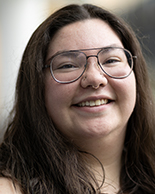 Kaela Villafania is a PhD student pursuing a degree in physics from MSU. She is advised by Ting Xu, Superconducting Radio Frequency and Superconducting Magnet Department Manager and professor of physics from the MSU Department of Physics and Astronomy. Kaela’s area of research is in the superconducting radio frequency field. She has been a member of the ASET program since 2024.
Kaela Villafania is a PhD student pursuing a degree in physics from MSU. She is advised by Ting Xu, Superconducting Radio Frequency and Superconducting Magnet Department Manager and professor of physics from the MSU Department of Physics and Astronomy. Kaela’s area of research is in the superconducting radio frequency field. She has been a member of the ASET program since 2024.
What are your research responsibilities?
After joining this past summer, I have worked on RF/DC testing of the photocathode stalk for the LCLS-II-HE electron gun as well as worked on the microphonics investigations for the LCLS-II-HE electron gun cryomodule. I am currently assisting in measurements of ponderomotive instabilities for the FRIB cryomodules.
What interested you about the ASET program/pursuing this educational path?
Accelerator science, specifically SRF technology, is very interesting and there are many “hats” we get to wear as SRF scientists. I have been able to conduct simulation work as well as perform experimental work so every day feels novel.
How do you think participating in the ASET program at MSU will benefit for your career?
I have been fortunate to attend USPAS under the ASET program which directly increases my knowledge and network in the field. ASET has strong ties to the national laboratories, which allows me to gain first-hand experience in the career path I am pursuing. It has created a sense of belonging in the field that I wouldn’t have had opportunity for otherwise.
What career path do you plan to pursue at this point?
I want to pursue a career at a national laboratory or as a professor at a university.
Would you recommend the ASET program to other students? Why?
I would recommend the ASET program because there are invaluable opportunities that the program presents. Networking as well as the opportunities to work alongside leaders and experts in the field is invaluable.
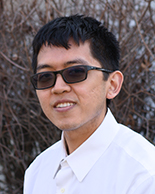 Anthony Tran is a PhD student pursuing a degree in accelerator physics from MSU. His advisor is Yue Hao, professor of physics from the MSU Department of Physics and Astronomy. Anthony’s research topic includes data-driven analysis of accelerators, including machine learning and tomography in order to reduce beam loss. He has been a member of the ASET program since 2020.
Anthony Tran is a PhD student pursuing a degree in accelerator physics from MSU. His advisor is Yue Hao, professor of physics from the MSU Department of Physics and Astronomy. Anthony’s research topic includes data-driven analysis of accelerators, including machine learning and tomography in order to reduce beam loss. He has been a member of the ASET program since 2020.
What are your research responsibilities?
My research responsibilities are understanding and developing techniques for tomography in accelerators. At the moment, it is the implementation of a pepper pot into the ALTAS beam line at Argonne.
What interested you about the ASET program/pursuing this educational path?
ASET leads me into the accelerator field. It is challenging but also a small community relative to other fields. That means people who stay in it know each other and are close to each other. I enjoy being in this field.
How do you think participating in the ASET program at MSU will benefit for your career?
The program has given me experience with accelerators, a breadth of knowledge, and specific knowledge. It also allows me to make connections with other accelerator scientists through meetings, conferences, and especially the US Particle Accelerator School.
What career path do you plan to pursue at this point?
I plan to continue working in accelerators and eventually get a scientist position at a national laboratory in accelerators.
The ASET program can support your stay at a national laboratory – at which laboratory are you interested in further your training and what are your research interests there?
At the moment, I’m interested in working at Argonne National Laboratory because they have some machine learning research there and an accessible accelerator to test my ideas on.
Would you recommend the ASET program to other students? Why?
I recommend ASET to physics majors in their last years of studies. I encourage them to check out the field, as it is a good community for them to be in the future.
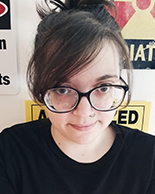 Aubrey Lokey is a PhD student pursuing a degree in physics from MSU. She is advised by Steven Lidia, FRIB senior physicist and adjunct professor of physics and electrical and computer engineering from the MSU Department of Physics and Astronomy. Aubrey's area of research is developing a gas sheet beam-induced fluorescence profile monitor for heavy ion accelerators. She has been a member of the ASET program since 2020.
Aubrey Lokey is a PhD student pursuing a degree in physics from MSU. She is advised by Steven Lidia, FRIB senior physicist and adjunct professor of physics and electrical and computer engineering from the MSU Department of Physics and Astronomy. Aubrey's area of research is developing a gas sheet beam-induced fluorescence profile monitor for heavy ion accelerators. She has been a member of the ASET program since 2020.
What are your research responsibilities?
I am currently developing a diagnostics device for measuring the transverse profile of high-intensity heavy-ion beams in a minimally invasive way. My responsibilities include design, physics simulations, estimation of expected device performance, and eventually build up and bench testing.
What interested you about the ASET program/pursuing this educational path?
I am interested in electronics and telemetry, and came from a computer engineering and aerospace background. I am particularly interested in radiation effects on semiconductors, although I hadn’t had the opportunity to learn about the actual machines used for these tests up until this point. Members of my family work in radiological healthcare, and so I was introduced to the idea of accelerator-based cancer treatments, which is also really interesting me. I was drawn to MSU because of the world class lab facility and came into the ASET program because it seemed like a really great way to learn about accelerator science and the development of these facilities in a hands-on and in-depth way.
How do you think participating in the ASET program at MSU will benefit for your career?
I’ve had the opportunity to attend conferences for networking and USPAS courses for furthering my education. Creating contacts in the field will be very valuable as I move to the next stage of my career, and the USPAS courses provide a great background for getting a broad understanding of many topics that would otherwise be hard to cover in more traditional courses.
What career path do you plan to pursue at this point?
At this point, I am potentially looking to work in the private sector with companies developing medical accelerators. I would also be interested in working with companies and lab facilities for semiconductor radiation testing, so it’s going to depend on where I would like to go after graduation.
The ASET program can support your stay at a national laboratory – at which laboratory are you interested in further your training and what are your research interests there?
Fermilab has had people working on a similar device to the one that I’m developing here, so that would possibly be a good fit.
Would you recommend the ASET program to other students? Why?
I would definitely recommend this program to any students interested in pursuing accelerator science and related fields. The courses are invaluable, it’s a really great opportunity for learning and professional development, and they offer support for conferences, stays at national laboratories and more.
William Fung is a PhD student pursuing a degree in accelerator physics at MSU. William is advised by Yue Hao, professor of physics from the MSU Department of Physics and Astronomy. His research topic is luminosity optimization at the Pioneering High Energy Nuclear Interaction eXperiment (sPHENIX), a detector at the Brookhaven National Laboratory. William has been a part of the ASET program since 2022.
What are your research responsibilities?
Running beam-beam simulations and ML algorithms, analyzing BPM data, reading related papers, and running experiments at RHIC control room.
What interested you about the ASET program/pursuing this educational path?
The abundant number of resources they provide at FRIB in terms of accelerator physics for students pursuing accelerator-based research careers.
How do you think participating in the ASET program at MSU will benefit for your career?
The ASET program helps make networking easier as well as provides many learning opportunities.
What career path do you plan to pursue at this point?
After I earn my PhD, I plan to work at a national lab/accelerator facility as a staff scientist. I am aiming to aid EIC experiments in the future.
The ASET program can support your stay at a national laboratory – at which laboratory are you interested in further your training and what are your research interests there?
I am currently situated at BNL working on projects at RHIC and potentially NSLS-II in the future. I am currently interacting with the professional environment at the lab as well as learning about their experimental, planning, and safety procedures.
Would you recommend the ASET program to other students? Why?
I would recommend it since not only are the resources for accelerator students beneficial to their research projects, but also for their future career as scientists and professionals. There are also many opportunities to work on accelerator projects at or outside of FRIB.
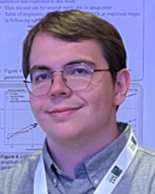 Jacob Brown is a PhD student pursuing a degree in physics at MSU. A native of Cleveland, Ohio, his advisor is Ting Xu, Superconducting Radio Frequency and Superconducting Magnet Department Manager and professor of physics from the MSU Department of Physics and Astronomy. For his research, Jacob is focusing on how the electromagnetic fields in superconducting radio frequency (SRF) cavities can couple with mechanical vibrations to impact cavity performance. He joined the MSU ASET program in 2022.
Jacob Brown is a PhD student pursuing a degree in physics at MSU. A native of Cleveland, Ohio, his advisor is Ting Xu, Superconducting Radio Frequency and Superconducting Magnet Department Manager and professor of physics from the MSU Department of Physics and Astronomy. For his research, Jacob is focusing on how the electromagnetic fields in superconducting radio frequency (SRF) cavities can couple with mechanical vibrations to impact cavity performance. He joined the MSU ASET program in 2022.
What are your research responsibilities?
I am in charge of deciding measurement procedures when the availability to do measurements on cavities in the accelerator. I am also in charge for creating the setup for measurements of mechanical properties during our cavity certification tests.
What interested you about the ASET program/pursuing this educational path?
Accelerator sciences are a great way to get hands-on experience: setting up equipment, carrying out measurements, etc. The ASET program offered the classes I needed to get my foot in the door since I had no prior knowledge to accelerator science. It also presented a good opportunity to network with people at national labs to look for future work.
How do you think participating in the ASET program at MSU will benefit for your career?
It gave me the opportunity to travel to conferences and national labs, where I was able to network with other scientists. This has allowed me to pursue research with Fermi National Accelerator Laboratory (Fermilab), which has expanded my career and research resources.
What career path do you plan to pursue at this point?
My experience with FRIB and the ASET program has led me to pursue SRF research at an accelerator facility post-graduation.
The ASET program can support your stay at a national laboratory – at which laboratory are you interested in further your training and what are your research interests there?
I have already visited and worked at Fermilab for a summer, where I received more training on SRF cavity testing and conducted simulations for electron multipacting in cavities. My advisor and I are planning on doing collaborative work with scientists there in the future in support of my thesis.
Would you recommend the ASET program to other students? Why?
I would highly recommend the ASET program. The classes that come with the program give you a great base understanding of accelerators as machines, and experts in specific fields can help you dive deeper into your specific interests. The ASET program also allows you to present your work at conferences and network with other scientists, which can be an invaluable experience.
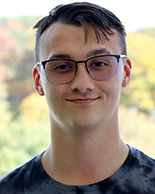 Malachi Keener is a PhD student pursuing a degree in electrical and computer engineering from MSU. His advisor is Leo Kempel, dean of MSU’s College of Engineering. For his research, he is focusing on conformal antennas and field reflections within and on a cavity. Malachi has been a member of the ASET program since 2023.
Malachi Keener is a PhD student pursuing a degree in electrical and computer engineering from MSU. His advisor is Leo Kempel, dean of MSU’s College of Engineering. For his research, he is focusing on conformal antennas and field reflections within and on a cavity. Malachi has been a member of the ASET program since 2023.
What are your research responsibilities?
Derive equations for the fields everywhere in space, reflected from a conducting surface of any shape. In a transmitter case, apply boundary conditions of conducting surface and aperture opening for field equations.
What interested you about the ASET program/pursuing this educational path?
I took a field trip in high school to NSCL/FRIB, and it garnered an interest in nuclear fusion and elementary particle interactions. I have gotten into a physics program and then an electrical engineering program to study these interactions with a practical approach and biding my time until I could attend the Accelerator traineeship graduate program.
How do you think participating in the ASET program at MSU will benefit for your career?
I believe the ASET program will provide my potential career path with more breadth in that I will be able to pivot my antenna background to accelerator-related topics. I think training in accelerator topics has provided a new perspective to couple with my background knowledge allowing a more holistic approach to new problems/ new topics of study.
What career path do you plan to pursue at this point?
As of right now I am generally an RF/ Antenna design engineer, and I have a couple more years to figure out exactly what I’d like to do with that. I think accelerators are awesome and I like learning about them, so I hope to continue learning about them and if that amounts to a career I’d be pleased.
The ASET program can support your stay at a national laboratory – at which laboratory are you interested in further your training and what are your research interests there?
As of right now I have very limited knowledge of what specific research laboratories are performing. Generally, I think Isotope creation (Fusion in general), elementary particle investigation, and x-ray irradiation for medical applications are all fascinating. Any sort of experience of that nature in a lab I think would be valuable and interesting.
Would you recommend the ASET program to other students? Why?
I think if you have any interest in accelerator topics ASET is great, as it allows you to come from almost any stem background and participate in these topics and provides opportunities to immerse yourself within the topic and network/ talk with those also in that field.
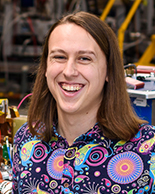 John Wieland is a PhD student pursuing a degree in physics at MSU. His advisor is Peter Ostroumov, associate director of the FRIB Accelerator Systems Division and professor in MSU’s Department of Physics and Astronomy. For his research, he is exploring experimental beam dynamics studies, specifically with nonlinear integrable optics. John joined the ASET program in 2020.
John Wieland is a PhD student pursuing a degree in physics at MSU. His advisor is Peter Ostroumov, associate director of the FRIB Accelerator Systems Division and professor in MSU’s Department of Physics and Astronomy. For his research, he is exploring experimental beam dynamics studies, specifically with nonlinear integrable optics. John joined the ASET program in 2020.
What are your research responsibilities?
I am engaged in the full breadth of beam dynamics studies. I perform analytical and simulation studies for experimental design. I operate the accelerator for data collection. And, I perform data post-processing and analysis.
What interested you about the ASET program/pursuing this educational path?
I was interested in colliders in undergrad, and applied to every accelerator physics program I could find. ASET stuck out in its broad scope of thesis research opportunities.
How do you think participating in the ASET program at MSU will benefit for your career?
The ASET program has provided me a great launchpad into the Accelerator physics community. I get to work with many subject matter experts and ASET provides support to attend conferences.
What career path do you plan to pursue at this point?
I hope to continue as a staff scientist at a national lab.
The ASET program can support your stay at a national laboratory – at which laboratory are you interested in further your training and what are your research interests there?
I have been at Fermilab for the past two years working in the IOTA group.
Would you recommend the ASET program to other students? Why?
Absolutely, if you're interested in particle accelerator topics, the MSU ASET program is top notch in the nation right now. The opportunity to perform thesis studies at a national lab of your choice is a great way to engage in high impact research and get your foot in the door.
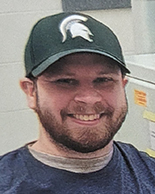 Ethan Fletcher is a PhD student pursuing a degree in physics at MSU. He is advised by Steven Lidia, FRIB senior physicist and adjunct professor of physics and electrical and computer engineering, and Takuji Kenemura, high power targetry department manager at FRIB. Ethan is researching radiation effects due to heavy ion implantation in FRIB beam intercepting devices. He has been a member of the ASET program since 2023.
Ethan Fletcher is a PhD student pursuing a degree in physics at MSU. He is advised by Steven Lidia, FRIB senior physicist and adjunct professor of physics and electrical and computer engineering, and Takuji Kenemura, high power targetry department manager at FRIB. Ethan is researching radiation effects due to heavy ion implantation in FRIB beam intercepting devices. He has been a member of the ASET program since 2023.
What are your research responsibilities?
I design, perform experiments and form the necessary collaborations to evaluate radiation effects on beam intercepting devices, in particular the charge selector. Experimental results will inform the design and implementation of future beam intercepting devices (BIDS) in the FRIB beamline.
What interested you about the ASET program/pursuing this educational path?
ASET provides a focused academic path to specialize in accelerator engineering. I enjoy knowing the theoretical and practical fundamentals behind my work, and the courses and programs offered and supported through ASET provide the perfect opportunity to accomplish my aims and goals.
How do you think participating in the ASET program at MSU will benefit for your career?
It gives me an idea of what career paths are available to me. It also supports coursework and external programs such as U.S. Particle Accelerator School, as well as travel to workshops and conferences that help me find the tools and knowledge necessary to accomplish my current work, and give me an idea of what I want to do with my future.
What career path do you plan to pursue at this point?
I’d like to continue working in an accelerator facility.
The ASET program can support your stay at a national laboratory – at which laboratory are you interested in further your training and what are your research interests there?
Either Pacific Northwest National Lab or Oak Ridge National Lab. Both labs have extensive facilities dedicated to post irradiation examination (PIE), which is the bulk of my current PhD work. These places would be perfect to receive training in rigorous PIE methods and learn about the tools available to accomplish this important work.
Would you recommend the ASET program to other students? Why?
Yes. ASET provides a great amount of support to your academic endeavors as helping you in your career aspirations through the myriad of courses they offer and programs they support.
Sean Moskaitis is a PhD student pursuing a degree in accelerator physics from MSU. He is advised by Peter Ostroumov, associate director of the FRIB Accelerator Systems Division and professor in MSU’s Department of Physics and Astronomy, and Sang-hoon Kim, FRIB superconducting radio frequency (SRF) systems engineering and testing group leader. Sean has worked on multiple projects since starting at MSU, from designing cavities to writing an application to verify cavity synchronous phases. He is currently working on simulating beam losses in the accelerator and improving the accuracy of our models to reduce beam tuning time. He has been a part of the ASET program since 2022.
What are your research responsibilities?
My research responsibilities include: setting up and running/managing experiments; data analysis of experimental data; literature study and consideration of experimental data to form conclusions; presenting conclusions and steps forward to research group; and running simulations related to future experiments
What interested you about the ASET program/pursuing this educational path?
My interest in the field and the ability to have many options for experimental work.
How do you think participating in the ASET program at MSU will benefit for your career?
Providing me with valuable experience in the field which will prepare me for future work post graduate school.
What career path do you plan to pursue at this point?
Research in the accelerator field after my PhD.
The ASET program can support your stay at a national laboratory – at which laboratory are you interested in further your training and what are your research interests there?
Fermilab is of interest for access to sufficient resources to study material samples as it would help me with my work towards reducing cavity surface resistance.
Would you recommend the ASET program to other students? Why?
Yes, because it is extremely helpful in learning experimentally-relevant information and having plenty of experimental work options to choose from.
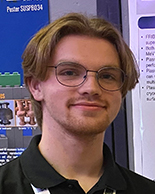 Patrick Tutt is a PhD student pursuing a degree in physics from MSU. He is under the advisement of Ting Xu, Superconducting Radio Frequency and Superconducting Magnet Department Manager and professor of physics from the MSU Department of Physics and Astronomy. Patrick’s area of research includes the development of dual-tone higher-order-modes for plasma processing of FRIB SRF coaxial resonators. He has been a part of the ASET program since 2024.
Patrick Tutt is a PhD student pursuing a degree in physics from MSU. He is under the advisement of Ting Xu, Superconducting Radio Frequency and Superconducting Magnet Department Manager and professor of physics from the MSU Department of Physics and Astronomy. Patrick’s area of research includes the development of dual-tone higher-order-modes for plasma processing of FRIB SRF coaxial resonators. He has been a part of the ASET program since 2024.
What are your research responsibilities?
Develop new plasma processing recipes by performing plasma measurements and simulations on FRIB coaxial resonators.
What interested you about the ASET program/pursuing this educational path?
Particle accelerators are powerful and complex machines that contribute to fundamental science across many fields. The ASET program provides education in the many aspects of accelerator science and engineering, allowing for in-depth understanding in each element needed to make large-scale accelerators function effectively. Being a part of such a large scale project that aims to explore fundamental science is of great interest to me.
How do you think participating in the ASET program at MSU will benefit for your career?
Participation in the ASET program will provide an education across many subfields of physics allowing for career options in industry, academia, and at DOE labs.
What career path do you plan to pursue at this point?
SRF (superconducting radio frequency) physicist/engineer at DOE national laboratory.
The ASET program can support your stay at a national laboratory – at which laboratory are you interested in further your training and what are your research interests there?
Brookhaven National Laboratory (BNL) will operate the new Electron-Ion Collider (EIC). This machine will allow for the internal structure of subatomic particles to be studied at greater resolution than ever before. The facility will need extensive support from accelerator physics and engineers and may especially need SRF technology to succeed. It would be of interest to me to help support this project from an SRF position and continue to develop my own SRF skills at BNL.
Would you recommend the ASET program to other students? Why?
Yes. For students interested in accelerators and their technology, the ASET program is an excellent way to learn about the many types of physics and engineering involved in constructed and operating such a large scale machine.
Testimonials from past ASET students
Get started in the ASET program at FRIB
FRIB’s ASET program, for actively registered graduate students pursuing a PhD or master’s degree at MSU in the Department of Physics and Astronomy or the College of Engineering; and FRIB’s graduate fellowships, for qualified U.S. graduate students who wish to carry out their thesis research at FRIB, are open to U.S. citizens or permanent residents.
Questions? Please visit our FRIB graduate studies page.
Support for several kinds of graduate fellowships in ASET are provided by the U.S. Department of Energy Office of Science (DOE-SC) Office of High Energy Physics, and the DOE-SC Office of Nuclear Physics.
Participate in unique and exciting training and internship programs that lead to career success.
Make real advancements through research projects and a variety of professional development opportunities.
Train for specialized careers in in-demand fields.
Develop the skills needed for a successful career in accelerator science.
Attend seminars presented by experts in the accelerator science and engineering field.
Read theses and testimonials from current and former ASET graduate students.

